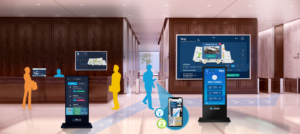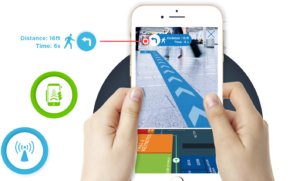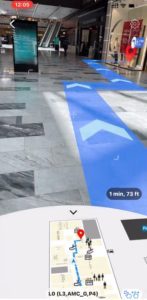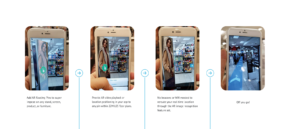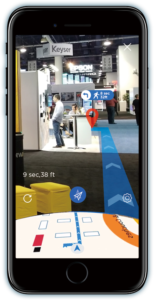Augmented reality is far from a new concept. Once a futuristic vision, a decade of innovation in AR has brought a wake of improvements to supporting technologies including content management, machine learning and AI, digital twins, and voice control – giving AR solutions a well-deserved boost into day-to-day technologies.
Navigating the Modern Twists with AR Wayfinding.
As a supplement to and extension of digital signage and wayfinding experiences, AR wayfinding can have enormous practical impact—and the technology ecosystem is finally in place to make it easy to implement.
Across industries, organizations “hire” digital signage deployments for a lot of different jobs including wayfinding; advertising and revenue generation; education; and mass notification. What’s more, users increasingly expect digital signage to transcend one-way, stagnant experiences to offer interactive, personalized experiences. Especially in large facilities, dispersed campuses, and busy public spaces, AR in wayfinding can provide essential support to digital signage missions. AR helps create outstanding experiences throughout a facility on user’s personal devices.
Latest innovations in augmented and virtual reality, along with some veteran features of digital signage like touch, voice, and QR code interactions, allow facilities to partner with systems experts to cultivate one-of-a-kind experiences that not only immerse users, but also go with them anywhere.
AR Wayfinding: A Breakdown.
With AR wayfinding, the interface reacts to imagery in the user’s environment to create a real-world digital guide, which can be especially helpful in unfamiliar environments.
The user journey begins at the digital sign, where visitors can view the full floor maps and get initial directions. Via the screen on a mobile phone or tablet, an AR solution can then provide turn-by-turn directions overlaid on the camera’s view, adjusting by location based on where the user moves. Using an app customized to the location, they can receive real-time direction, proximity, and information about their whereabouts.
Some environments, like tradeshows, are novel by nature, built from scratch for each event. Due to new capacity and traffic management policies implemented in the wake of COVID, however, even familiar environments like an office, home stadium, or school campus can turn strangely alien. One-way traffic and contact reduction remain an integral pillar of public health management. AR can help visitors navigate these spaces in safety and confidence.
AR takes the guesswork out of wayfinding, giving a visual and auditory cue as users navigate and confirming arrival at a destination. This not only removes the need for interactive maps and crowding around single screens by putting navigation at a user’s fingertips, but also offers a leg up in digital transformation to improve the customer experience.
With computer vision built-in to the AR experience, users can scan for landmarks to identify real world locations and orient based on the image recognition technology. This solution is suitable to act as an indoor positioning system leveraging AI with image recognition technology. With computer vision implemented, visual cues for wayfinding appear in real time and float on a mobile device with AR pins, communicating walking distance, rerouting, promotional content and more with augmented imagery.
AR Wayfinding Use Cases in Retail, Advertising, and Education.
Use cases for AR span a variety of industries. AR overlay can include video pins, animations, promotions and calls to action. As an individual enters a store, for instance, the AR app can recognize items and call up pricing information, promotions, material variants and reviews, offering a seamless blend of brick-and-mortar experience and e-commerce convenience. In a tradeshow or retail environment, sponsorships and promotions can be organically integrated into the user journey, triggered based on proximity.
The immediacy and convenience of AR promotions increases the odds of an impulsive engagement, driving high ROI for advertisers. In addition, personalized, proximity-based information is equally effective for education and for commerce. In a museum or historical site, AR can provide an information overlay.
Notifications/Policies.
One of the key advantages of a digital system- AR or digital signage – is real-time responsiveness. That’s a substantial advantage as facilities evolve policies to protect visitor health and safety and manage access to areas on a schedule that sometimes shifts several times per day. The AR overlay can include pop-ups with guidelines and rules along the route, adjusting in real time if a certain area is closed or open. Because users remain engaged as they move through the space, data from the app may also be useful for contact tracing in some instances.
Other use cases for notifications through AR include hoteling and hotdesking – an increasingly growing practice in the agile workplace. On-screen animations and popups can inform occupants about their locations and scheduled destinations, while administrators can monitor the whereabouts and occupancy of the facility through live feedback.
Accessibility.
While most people think of AR as just a visual communications technology, AR wayfinding can also incorporate auditory feedback. With voice control and audible responses for indoor guidance, AR solutions for wayfinding have the potential to greatly improve a mobile app’s accessibility. A powerful new solution for ADA requirements and benefits, the dual modality of visual and auditory wayfinding works by constantly monitoring the position and location of the user and their mobile device, like a GPS system for indoor navigation.
The fact that AR’s personal device increases this benefit, as many users with disabilities have personalized accessibility settings on their mobile device, such as a Bluetooth connection to a hearing aid.
Superior Design.
Works of science fiction like Blade Runner and Altered Carbon have imagined Augmented Reality as a hellscape of digital noise, distracting and disorienting consumers as they move through a space. The ironic truth is that it actually enables the opposite: sleek, minimalist design with on-demand information.
Incorporating augmented reality product information, notifications, and wayfinding into a digital signage deployment allows balance between communications and aesthetic requirements. Physical signs orient visitors as they enter a space or move through key areas, while the augmented reality experience is available to support them if they want more information about a certain product or feature or need help navigating the facility.
How AR Wayfinding Has Gotten Easier to Implement.
AR used to be a luxury solution, bespoke developed only for those with the deepest pockets. Now, content management software with plug-and-play templates have placed it within reach of every facility. Pop-ups and routes can promote specific guidelines and rules of a given facility, advertise trending products and events to promote sales, and give real-time feedback to ensure that the user feels comfortable heading in the right direction, all without the need for extensive custom programming. It’s completely personalized user experience, right out of the box.
As high-traffic facilities like airports, medical building, college campuses, and sports arenas adapt to the complex public health situation and welcome visitors, the demand for intuitive and immersive indoor navigation systems increases. Recent innovations in software-as-a-service make it easy for any venue, business manager, or organization to incorporate it into their wayfinding signage and apps – improving accessibility, user experience, and a company’s digital transformation.
To learn more about AR wayfinding and the 22Miles technology, click here.
